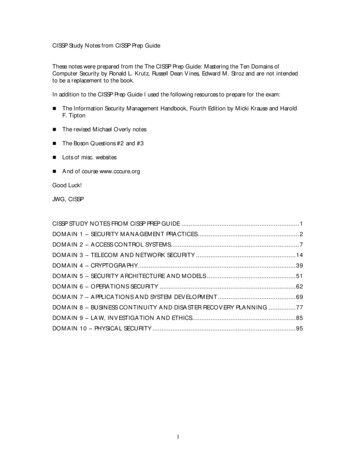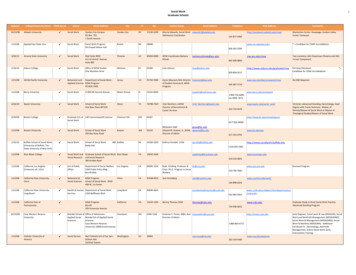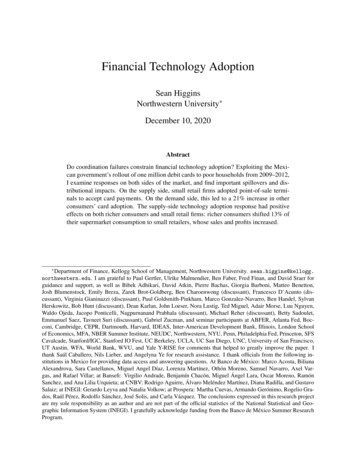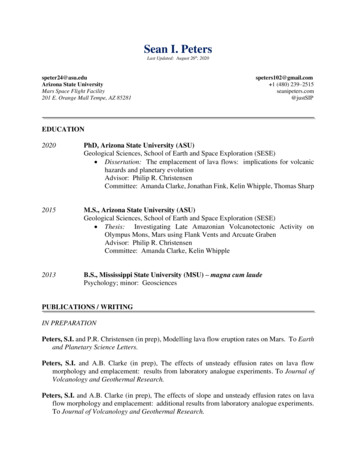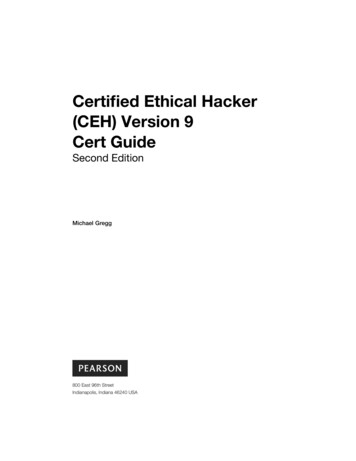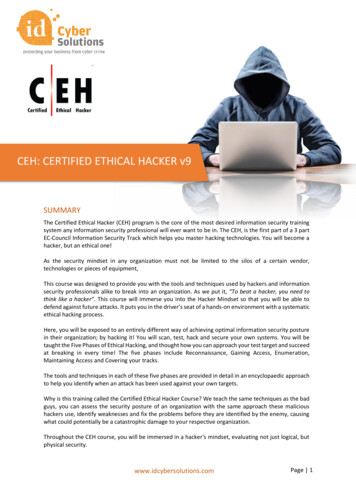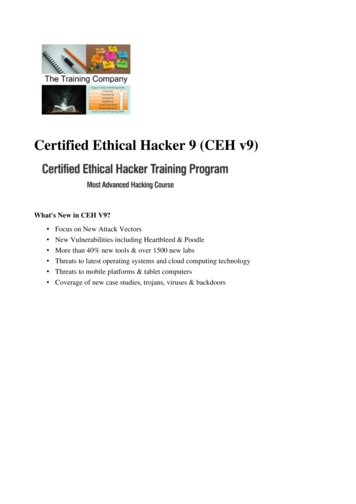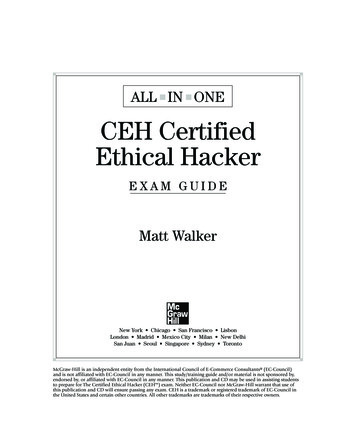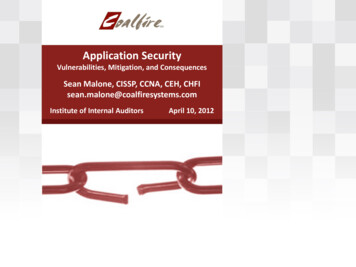
Transcription
Application SecurityVulnerabilities, Mitigation, and ConsequencesSean Malone, CISSP, CCNA, CEH, CHFIsean.malone@coalfiresystems.comInstitute of Internal AuditorsApril 10, 2012
Overview“Getting Technical”1. Application vulnerabilities & how to avoid them2. Security breaches & how they could have been prevented
Types of Vulnerabilities:OWASP Top Ten (2010 Edition)A1: InjectionA2: Cross-SiteScripting (XSS)A3: BrokenAuthentication andSessionManagementA5: Cross SiteRequest Forgery(CSRF)A6: SecurityMisconfigurationA7: Failure toRestrict URL AccessA9: InsufficientTransport LayerProtectionA10: UnvalidatedRedirects andForwardsA4: Insecure DirectObject ReferencesA8: ndex.php/Top 10
A1 – InjectionInjection means Tricking an application into including unintended commands in the data sent to aninterpreterInterpreters Take strings and interpret them as commands SQL, OS Shell, LDAP, XPath, etc SQL injection is still quite common Many applications still susceptible Even though it’s usually very simple to avoidTypical Impact Usually severe. Entire database can usually be read or modified May also allow full database schema, or account access, or even OS level access
Custom CodeBillingDirectories Acct:5424-9383-2039-4029Acct:4128-0004-1234-02933. Application forwards attack tothe database in a SQL queryWeb ServerFirewallHardened OSFirewallDB Table "SELECT * FROMAccount SummaryAccount:Account:accounts WHERESKU:SKU:acct ‘’OR 1 ’"1. Application presents a form tothe attacker2. Attacker sends an attack inthe form dataApp ServerNetwork LayerHuman ResrcsATTACK Web ServicesHTTPSQLresponsequery HTTPrequestAPPLICATIONLegacy SystemsDatabasesCommunicationKnowledge MgmtE-CommerceBus. Application LayerSQL Injection – Illustrated4. Database runs querycontaining attack and sendsencrypted results back toapplication5. Application decrypts data asnormal and sends results to theuser
A1 – Avoiding Injection Flaws Recommendations1. Avoid the interpreter entirely, or2. Use an interface that supports bind variables (e.g., preparedstatements, or stored procedures), Bind variables allow the interpreter to distinguish between code and data3. Encode all user input before passing it to the interpretero Always perform whitelist input validation on all user supplied inputo Always minimize database privileges to reduce the impact of a flaw Referenceso For more details, seehttp://www.owasp.org/index.php/SQL Injection Prevention Cheat Sheet
A2 – Cross-Site Scripting (XSS)Occurs any time Raw data from attacker is sent to an innocent user’s browserRaw data Stored in database Reflected from web input (form field, hidden field, URL, etc ) Sent directly into rich JavaScript clientTypical Impact Steal user’s session, steal sensitive data, rewrite web page, redirect userto phishing or malware site Most Severe: Install XSS proxy which allows attacker to observe and directall user’s behavior on vulnerable site and force user to other sites
Cross-Site Scripting IllustratedAttacker sets the trap – update my profileVictim views page – sees attacker profileCommunicationKnowledgeMgmtE-CommerceBus. Functions2AdministrationTransactionsAttacker enters amalicious script into aweb page that storesthe data on the serverApplication withstored XSSvulnerabilityAccountsFinance1Custom CodeScript runs insidevictim’s browser withfull access to the DOMand cookies3Script silently sends attacker Victim’s session cookie
A2 – Avoiding XSS Flaws Recommendationso Eliminate Flaw Don’t include user supplied input in the output pageo Defend Against the Flaw Primary Recommendation: Output encode all user supplied inputPerform whitelist input validation on all user input to be included in pageFor large chunks of user supplied HTML, use OWASP’s AntiSamy to sanitizethis HTML to make it safeSee: http://www.owasp.org/index.php/AntiSamy Referenceso For how to output encode properly, seehttp://www.owasp.org/index.php/XSS (Cross Site Scripting) Prevention Cheat Sheet
A3 – Broken Authentication and Session ManagementHTTP is a “stateless” protocol Means credentials have to go with every request Should use SSL for everything requiring authenticationSession management flaws SESSION ID used to track state since HTTP doesn’t and it is just as good as credentials to an attacker SESSION ID is typically exposed on the network, in browser, in logs, Beware the side-doors Change my password, remember my password, forgot my password, secretquestion, logout, email address, etc Typical Impact User accounts compromised or user sessions hijacked
www.boi.com?JSESSIONID 9FA1DB9EA.Site uses URL rewriting(i.e., put session in URL)35Hacker uses JSESSIONIDand takes over victim’saccount2Custom CodeUser clicks on a link tohttp://www.hacker.com in a forumHacker checks referrer logs onwww.hacker.comand finds user’s JSESSIONIDCommunicationKnowledgeMgmtE-CommerceBus. FunctionsUser sends onsBroken Authentication Illustrated4
A3 – Avoiding Broken Authentication and Session Management Verify your architectureo Authentication should be simple, centralized, and standardizedo Use the standard session id provided by your containero Be sure SSL protects both credentials and session id at all times Verify the implementationooooManually attempt to bypass authenticationTrack the session ID and ensure that it is protectedExamine all the authentication-related functionsVerify that logoff actually destroys the session Follow the guidance fromo http://www.owasp.org/index.php/Authentication Cheat Sheet
A4 – Insecure Direct Object ReferencesHow do you protect access to your data? This is part of enforcing proper authorization, along withA7 – Failure to Restrict URL AccessA common mistake Only listing the ‘authorized’ objects for the current user, or hiding theobject references in hidden fields and then not enforcing these restrictions on the server side This is called presentation layer access control, and doesn’t work Attacker simply tampers with parameter valueTypical Impact Users are able to access unauthorized files or data
Insecure Direct Object References Illustratedhttps://www.onlinebank.com/user?acct 6065 Attacker notices his acctparameter is 6065?acct 6065 He modifies it to a nearbynumber?acct 6066 Attacker views thevictim’s accountinformation
A4 – Avoiding Insecure Direct Object References Eliminate the direct object referenceo Replace them with a temporary mapping value (e.g. 1, 2, 3)http://app?file Report123.xlshttp://app?file 1http://app?id 9182374http://app?id 7d3J93AccessReferenceMapReport123.xlsAcct:9182374 Validate the direct object referenceo Verify the parameter value is properly formattedo Verify the user is allowed to access the target objecto Verify the requested mode of access is allowed to the target object(e.g., read, write, delete)
A5 – Cross Site Request Forgery (CSRF)Cross Site Request Forgery An attack where the victim’s browser is tricked into issuing a command to avulnerable web application Vulnerability is caused by browsers automatically including user authenticationdata (session ID, IP address, Windows domain credentials, ) with each requestImagine What if a hacker could steer your mouse and get you to click on links in youronline banking application? What could they make you do?Typical Impact Initiate transactions (transfer funds, logout user, close account) Access sensitive data Change account details
CSRF Vulnerability Pattern The Problemo Web browsers automatically include most credentials with each requesto Even for requests caused by a form, script, or image on another site All sites relying solely on automaticcredentials are vulnerable Automatically Provided CredentialsoooooSession cookieBasic authentication headerIP addressClient side SSL certificatesWindows domain authentication
CSRF IllustratedWhile logged into vulnerable site,victim views attacker siteCommunicationKnowledgeMgmtE-CommerceBus. Functions2Application withCSRF vulnerabilityAdministrationTransactionsHidden img tagcontains attackagainst vulnerablesiteAccountsFinance1Attacker sets the trap on some website on the internet(or simply via an e-mail)Custom Code3 img tag loaded bybrowser – sends GETrequest (includingcredentials) tovulnerable siteVulnerable site seeslegitimate requestfrom victim andperforms the actionrequested
A5 – Avoiding CSRF Flaws Add a secret, not automatically submitted, token to ALL sensitive requests Optionso This makes it impossible for the attacker to spoof the request (unless there’s an XSS hole in your application)o Tokens should be cryptographically strong or randomo Store a single token in the session and add it to all forms and links Hidden Field: input name "token" value "687965fdfaew87agrde"type "hidden"/ Single use URL: /accounts/687965fdfaew87agrdeo Beware exposing the token in a referrer header Hidden fields are recommendedo Can have a unique token for each function Use a hash of function name, session id, and a secreto Can require secondary authentication for sensitive functions (e.g., eTrade) Don’t allow attackers to store attacks on your site to protect against XSSo Properly encode all input on the way outo This renders all links/requests inert in most interpretersFor more details, see www.owasp.org/index.php/CSRF Prevention Cheat Sheet
A6 – Security MisconfigurationWeb applications rely on a secure foundation Everywhere from the OS up through the App Server Don’t forget all the libraries you are using!!Is your source code a secret? Think of all the places your source code goes Security should not require secret source codeConfiguration Management must extend to all parts of the application All credentials should change in productionTypical Impact Install backdoor through missing OS or server patch XSS exploits due to missing application framework patches Unauthorized access to default accounts, application functionality or data, or unused butaccessible functionality due to poor server configuration
CommunicationKnowledge MgmtE-CommerceBus. Security Misconfiguration IllustratedDatabaseCustom CodeApp ConfigurationFrameworkDevelopmentApp ServerQA ServersWeb ServerInsiderHardened OSTest ServersSource Control
A6 – Avoiding Security Misconfiguration Verify your system’s configuration managemento Secure configuration “hardening” guideline Automation is REALLY USEFUL hereo Must cover entire platform and applicationo Keep up with patches for ALL components This includes software libraries, not just OS and Server applicationso Analyze security effects of changes Can you “dump” the application configuration?o Build reporting into your processo If you can’t verify it, it isn’t secure Verify the implementationo Scanning finds generic configuration and missing patch problems
A7 – Insecure Cryptographic StorageStoring sensitive data insecurely Failure to identify all sensitive data Failure to identify all the places that this sensitive data gets stored Databases, files, directories, log files, backups, etc. Failure to properly protect this data in every location Failure to use secure algorithmsTypical Impact Attackers access or modify confidential or private information e.g, credit cards, health care records, financial data (yours or your customers’) Attackers extract secrets to use in additional attacks Company embarrassment, customer dissatisfaction, and loss of trust Expense of cleaning up the incident, such as forensics, sending apologyletters, reissuing thousands of credit cards, providing identity theft insurance Business gets sued and/or fined
1Victim enters creditcard number in nicationKnowledgeMgmtE-CommerceBus. FunctionsInsecure Cryptographic Storage IllustratedCustom Code4Log filesMalicious insidersteals 4 millioncredit cardnumbersLogs are accessible toall members of IT stafffor debugging purposesError handler logs CCdetails becausemerchant gateway isunavailable32
A7 – Avoiding Insecure Cryptographic Storage Verify your architectureoooo Protect with appropriate mechanismso File encryption, database encryption, data element encryptionUse the mechanisms correctlyooo Identify all sensitive dataIdentify all the places that data is storedEnsure threat model accounts for possible attacksUse encryption to counter the threats, don’t just ‘encrypt’ the dataUse standard strong algorithmsGenerate, distribute, and protect keys properlyBe prepared for key changeVerify the implementationooooA standard strong algorithm is used, and it’s the proper algorithm for this situationAll keys, certificates, and passwords are properly stored and protectedSafe key distribution and an effective plan for key change are in placeAnalyze encryption code for common flaws
A8 – Failure to Restrict URL AccessHow do you protect access to URLs (pages)? This is part of enforcing proper authorization, along withA4 – Insecure Direct Object ReferencesA common mistake Displaying only authorized links and menu choices This is called presentation layer access control, and doesn’t work Attacker simply forges direct access to “unauthorized” pagesTypical Impact Attackers invoke functions and services they’re not authorized for Access other user’s accounts and data Perform privileged actions
Failure to Restrict URL Access unts Attacker notices the URLindicates his role/user/getAccounts He modifies it to anotherdirectory (role)/admin/getAccounts, or/manager/getAccounts Attacker views moreaccounts than just theirown
A8 – Avoiding URL Access Control Flaws For each URL, a site needs to do 3 thingso Restri
Sean Malone, CISSP, CCNA, CEH, CHFI sean.malone@coalfiresystems.com Institute of Internal Auditors April 10, 2012. Overview “Getting Technical” 1. Application vulnerabilities & how to avoid them .
